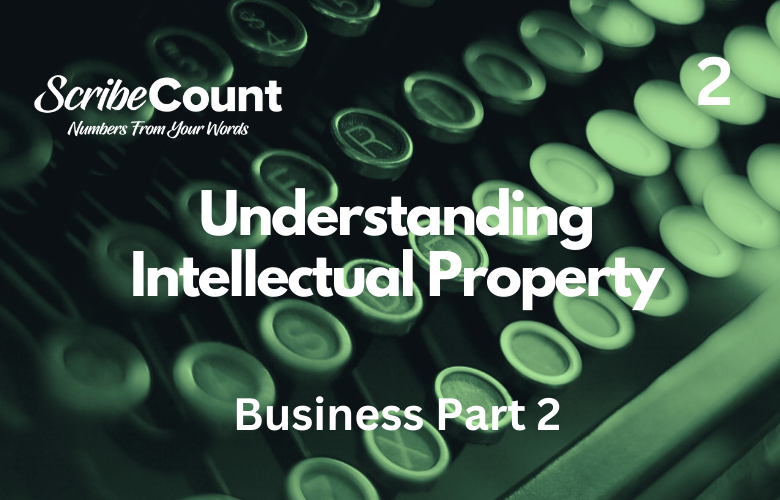Understanding Intellectual Property: A Guide for Authors
Most authors think they sell books. You write the thing, put a price tag on it, and then sell it to readers. Simple, right?
Not really.
A single book can be "sold" several times and in a variety of ways. A majority of the time this transaction is called “Licensing Intellectual Property”, and it’s important for authors to know and understand the difference. Intellectual Property (IP) is not just your creation, it’s your asset, and what you generate your income from. Knowing and understanding IP and how it works in the business world is probably the most important thing an author needs to know.
In our increasingly digital world, protecting and leveraging creative work has never been more crucial. Intellectual Property (IP) plays a pivotal role in safeguarding an author's rights and ensuring they benefit from their work. In this article we’ll cover the value of intellectual property, how it is marketed and sold, the significance of copyright, and the differences between selling eBooks and physical books. With a focus on novelists and online content creators, we will break down essential concepts and strategies for maximizing revenue and protecting creative endeavors.
What is Intellectual Property?
Intellectual Property (IP) refers to intangible assets derived from creative and intellectual efforts. For authors, IP includes novels, short stories, articles, blog posts, scripts, and any other written or verbal (audio) content. IP is legally protected through copyright, trademarks, patents, and trade secrets. However, for authors, copyright is the primary mechanism for protection.
Key Definitions
- Copyright: A legal right granting the creator of an original work exclusive rights to its use and distribution.
- Trademark: A symbol, word, or phrase legally registered to represent a brand or product.
- Patent: A form of protection for inventions and new processes.
- Public Domain: Works no longer under copyright protection, allowing free use by the public.
- Fair Use: A legal doctrine allowing limited use of copyrighted material without permission, usually for commentary, criticism, or educational purposes.
- Royalties: Payments made to an author for the use of their copyrighted work. Similar and related to “proceeds from sales”.
The Value of Intellectual Property for Authors
The value of IP extends beyond initial book sales. Intellectual Property can generate ongoing revenue, establish an author's brand, and open doors to licensing opportunities, adaptations, and merchandise. The key ways authors derive value from their IP include:
- Book Sales: Direct revenue from the sale of novels in physical and digital formats.
- Licensing Agreements: Allowing publishers, distributors, or other entities to use the work under agreed terms.
- Film and TV Adaptations: Selling rights to production companies for adaptations.
- Merchandising: Expanding a book’s brand through related products.
- Foreign Rights: Selling translation and distribution rights in different markets.
- Audiobooks: Generating additional income through narration and audio distribution.
- Subscription Services: Providing content through platforms like Kindle Unlimited, Scribd, or Patreon.
Marketing and Selling Intellectual Property
For authors, successfully marketing and selling their IP requires a combination of traditional and digital strategies.
1. Traditional Publishing vs. Self-Publishing
- Traditional Publishing: Involves working with a publishing house that handles editing, marketing, and distribution. Authors typically receive an advance and royalties.
- Self-Publishing: Authors retain full control and rights, using platforms like Amazon Kindle Direct Publishing (KDP), IngramSpark, and Kobo to distribute their work.
2. Digital Marketing Strategies
- Author Branding: Building a recognizable author identity through a website, social media, and consistent content.
- Email Marketing: Engaging with readers through newsletters and exclusive content.
- Social Media Promotion: Leveraging platforms like Twitter, Facebook, Instagram, and TikTok to reach potential readers.
- Content Marketing: Writing blogs, guest posts, and articles related to themes in the author's work.
- Search Engine Optimization (SEO): Ensuring content ranks well on search engines to attract organic traffic.
3. Monetizing Online Content
For authors who create blogs, serialized fiction, video, or other online content, monetization strategies include:
- Advertising Revenue: Earning money through Google AdSense or sponsored content.
- Affiliate Marketing: Promoting products or services for commission.
- Crowdfunding: Using platforms like Patreon and Kickstarter to receive support from fans.
As you can see by this list there are numerous opportunities for authors to leverage their content. Every one of them involves the licensing of intellectual property in some form.
The Importance of Copyright for Authors
Copyright law protects an author's work from unauthorized use, ensuring they benefit financially and maintain control over their content. Without copyright, others could freely copy, distribute, and profit from an author's hard work.
How Copyright Works
Copyright protection is automatic upon the creation of an original work. However, registering a copyright with a government office provides legal proof of ownership and enhances protection.
Enforcing Copyright
Authors should actively monitor their IP and take action against infringement. Tools such as Google Alerts, DMCA takedown notices, and legal action can help combat unauthorized use of copyrighted work.
Licensing vs. Selling Copyright
- Licensing: Allows authors to grant permission for specific uses while retaining ownership.
- Selling: Transfers ownership permanently, meaning the author no longer controls the work.
Copyright is a subject that deserves an in-depth understanding and is too long for our subject here. We cover copyright, how to obtain it, how to prove it, and how to defend it, in our Security section. The key take away is that you should have copyright registered on your content, and that having a copyright and proving a copyright are two very different things.
Selling vs. Licensing a Book: Understanding the Difference Using Amazon
In the digital age, purchasing a book does not always mean owning it in the traditional sense. While buying a physical book gives the reader complete ownership, digital books often come with licensing agreements that restrict usage. This distinction is particularly relevant when purchasing books through platforms like Amazon, where the rights and limitations of ownership can be quite different depending on the format.
Selling a Book: Traditional Ownership
When a book is sold in a traditional sense—whether in print or as an eBook without licensing restrictions—the buyer gains full ownership of that copy. This means the reader can keep, lend, resell, or even give away the book without interference from the seller or publisher. For example, when you purchase a physical book from Amazon, you receive a tangible product that you can read indefinitely, sell to a secondhand bookstore, or pass on to a friend.
The same principle applies to DRM-free (Digital Rights Management-free) eBooks, which are occasionally available from independent authors or publishers. If an eBook is sold without DRM, the buyer can download, transfer, and back up the file as they see fit. However, this level of ownership is rare in the digital marketplace, as publishers and distributors often prefer a licensing model.
Licensing a Book: Limited Rights for the Reader
Unlike a traditional sale, licensing a book does not grant full ownership to the buyer. Instead, the buyer is purchasing the right to access the content under specific conditions set by the seller or publisher. This is the model Amazon primarily uses for Kindle eBooks. When you "buy" a Kindle book on Amazon, you are actually obtaining a license to read it rather than owning the file outright.
This licensing agreement means that Amazon retains control over the book. The company can remove access to the book under certain conditions, such as if the publisher withdraws it from the platform or if there is a policy violation. Additionally, readers cannot legally resell, transfer, or lend the book in the same way they would with a physical copy. Some Kindle books allow lending for a limited time, but this is strictly controlled by Amazon’s policies.
How Ownership Differs for the Reader
The key difference between selling and licensing a book lies in the reader’s rights. With a physical book or a DRM-free digital copy, the buyer has true ownership and can use the book without restrictions. In contrast, a licensed book, such as a Kindle eBook, grants only conditional access, with Amazon retaining the power to revoke that access at any time.
This distinction has caused controversy among readers who assume that purchasing a digital book means they own it permanently. In reality, they are subject to Amazon’s terms of service, which can change over time. Cases have arisen where Amazon has removed books from customers’ libraries due to licensing issues, highlighting the risks of digital book licensing.
NOTE: As of February 26th, 2025, Amazon removed a feature from its website allowing readers to download purchased books to their computer and then copy them manually to a Kindle over USB.
Understanding the difference between selling and licensing a book is crucial for both authors and readers who want full control over their IP or purchase. While physical books and DRM-free eBooks offer true ownership, most digital books on platforms like Amazon come with licensing agreements that limit user rights. Readers who value permanence and flexibility should consider these factors when deciding how to acquire their books. Authors will have to decide what levels of protection they wish to add to their published content.
Protecting Intellectual Property in the Digital Age
As the internet makes content easily accessible, authors must take steps to protect their IP.
1. Digital Rights Management (DRM)
- What it does: Prevents unauthorized copying and distribution of eBooks.
- How to implement: Choose DRM-enabled platforms when publishing.
We mention DRM here as most platforms offer it during the upload process. However, most DRM is weak and easily defeated. We discuss the pros and cons of DRM in our Security section.
2. Monitoring for Piracy
- Google Search: Regularly check for illegal copies of your work.
- DMCA Notices: Request takedowns of pirated copies from websites.
- Watermarking: Adding unique markers to identify unauthorized distributions.
- Price Matching: Sales Platforms that have Price Matching clauses can lower the price of a book if it is found for sale at a lower price elsewhere. This is often an indication of piracy.
Piracy can be both good and bad for the indie author. We discuss Piracy in depth in our Security section.
3. Contract and Legal Protections
- Publishing Contracts: Ensure clarity on rights, royalties, and distribution terms.
- Work-for-Hire Agreements: Clearly define ownership when hiring ghostwriters or illustrators.
- Trademarking Brand Names: Protect series titles and author pen names.
Protecting your Intellectual Property is a broad subject. We’ve simplified this by breaking it down into bite-size pieces in the Security section.
Conclusion
Intellectual Property is a vital asset for authors, encompassing novels, online content, and related creative works. By understanding IP, copyright, marketing strategies, and the distinctions between digital and physical book sales, authors can maximize revenue while safeguarding their creations. In a rapidly evolving publishing landscape, staying informed and proactive is key to long-term success.

